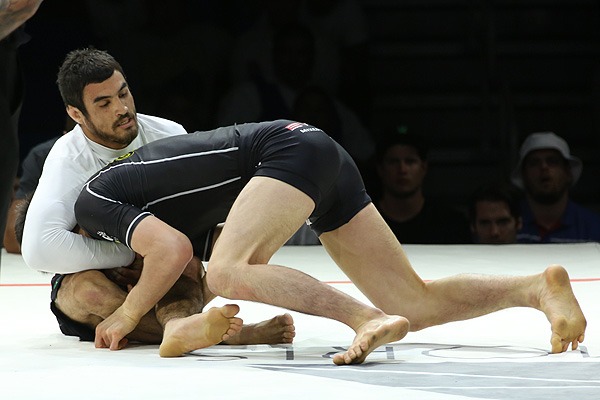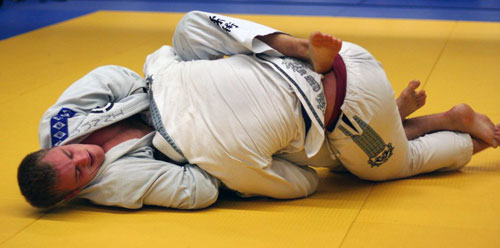
The guillotine choke has long been regarded as a strong man move. People involved in BJJ looked at it as just a one-off move useful mostly to MMA fighters. It was probably the emergence of Marcelo Garcia that started to change that impression. Marcelo managed to fine-tune and modify the guillotine to a deadly effect. That resulted in a greater awareness of the finer technical aspects of the choke. Today, guillotines can be seen in almost every competitive grappling environment done at every level of Jiu-Jitsu.
How many submissions do you know that you can get from both top and bottom positions as well as from standing? Arguably, there’s only one that ticks all these boxes. And it’s a tight one if the mechanics are in order. The guillotine choke is a mainstay in Jiu-Jitsu, granted, more on the No-GI side. It is, however, just as effective in the Gi. Actually, it might be even more effective, seeing how lots of people seem to disregard it on account of it being a No-Gi move. Check out Marcelo Garcia’s guillotine highlights to see how effective guillotines are.
What Is A Guillotine Choke?
The guillotine choke is a very versatile technique used in submission grappling arts, most of all, in Brazilian Jiu-Jitsu. It works as a choke, blocking off air or blood supply by pressuring the neck. Different grip variations provide different choking options, although the basics are the same – you grab an opponent’s head from the front, placing it under an armpit, and then place the forearm of the same side arm on their neck. That is the gist of it, although it is the details that actually make it perfect. Before we move on to them, though, let’s answer some of the most common questions people ask about guillotine chokes:
-
Who Invented The Guillotine Choke?
The choke has been around for too long to pinpoint the person that has come up with it. It is a part of old Judo curriculums where it appears the “Mae Hadaka Jime”, or front naked choke.
There’s also evidence of it in early catch wrestling matches, as well as some of the wrestling matches in the first Olympic games in ancient Greece. In other words, the Guilltince choke has been about as long as grappling martial arts have. Bruce Lee helped popularize it among martial arts fans with his “Way Of the Dragon” movie.
-
Is The Guillotine A Blood Choke?
Yes and no depending on the way you’re holding the guillotine choke on your opponent. However, it is much more efficient when done as a blood choke than an air choke.
If you’re after a high-percentage finish, it is blood choke. Making the guillotine choke work as a blood choke will require a bit of fitness and more training because it involves very precise placement of your forearm. In fact, it is the most efficient done as a blood choke with a chest compression component (more on that later).
-
What Happens In Guillotine Choke?
During a guillotine choke, you first achieve control, by not allowing the person you’re attacking to pull their head out. What happens as a result of the initial grip on the chin (chin strap) and the placement of your armpit behind the crown of the head. That way, there’s no pulling out, or p[osturing up.
Secondly, you can apply choking pressure as a result of the specific positioning of your arms. The end goal should be pressure on the carotid arteries on both sides of the neck, along with forcing the chin of the head towards the opponent’s chest. This leaves the opponent in a painful position, and without enough oxygen to make the brain work, so they either tap or they will go to sleep.
-
Is The Guillotine Choke Legal in BJJ?
In terms of adult belt levels, the guillotine choke is legal for every white belt to black, with and without the Gi. It is, however, illegal for kids and teenagers, until the age of 16. In those cases, even getting into the position can lend a competitor in trouble. In Judo, only the arm-in guillotine is allowed, while the position is legal in wrestling for control, but not for finishing, as there are no submissions allowed.
How to Do A Guillotine Choke
The guillotine choke in Brazilian Jiu-Jitsu is fairly simple if you understand how it works. In order for you to execute any of the plenty variations available, you to understand how to set up. Let’s break it down into several steps that are essential to tapping people out with guillotine chokes.
1. Grips
First and foremost, you’ll need to get a hold of the head. I’ll cover grip variations in detail later on, but for now, you should know that each allows you to keep control of the head, and position the arms for a choke. For most guillotine choke variations, though, you’ll need to grab your palms together in order to finish. Grips come first in the hierarchy of guillotines.
2. Position
In terms of positioning, you can go for a guillotine from the bottom, mainly from the closed guard, half guard, and open guard. The half guard offers options for attacking from the top as well, as does the mount. Attacking against the turtle is one of the most common setups, and you can even look to set guillotines up from standing.
3. Angle

4. Application Of Force
This is the most versatile part of a guillotine. In every grip variation, there are slight differences in how you apply force. The general guidelines, though, are not to pull but rather to squeeze everything, which angling as previously described makes possible. Next up, you should look to “tack” the opponent, so that their hin goes to their chest, causing a chest compression effect. Also, remember that twisting the arms so that different parts of your arms press on the neck is also crucial to wrapping a guillotine choke up.
5. Adjustments And Combos
Finally, the guillotine is a high-control p[ostion and offers the option of switching between its many variations at will. For example, if an arm-in guillotine is not working for you, you can switch to a low elbow, and then perhaps, even a high-elbow variation. Or, you could “marry” the guillotine with other front headlock chokes like neckties, Darces, and Anacondas.
Follow these 5 steps and you’ll be able to develop an air-tight guillotine game that will be a puzzle for everyone to solve.
Guillotine Choke Grip Variations
As simple as it might seem, the guillotine choke is had complex mechanics that require long-term practice. This is opposite to it being a brute choke that can be learned in a few classes. Shocking, I know, but if you want a Daniel Strauss-like guillotine, you need to learn the technical nuances.
The guillotine choke has two “main” varieties when it comes to execution. The original version involves trapping the opponent’s arm while going for the choke. That’s the “arm-in guillotine”, which acts as an air choke. The second variation is done without the arm and can be both blood and an air choke.
Both guillotine variations revolve around the same basic principles. The most important part is to utilize the correct part of the arm for the choke. To avoid mistakes, it is best to place your thumb on the outside of the opponent’s neck. This allows for correct placement of the wrist and easy transitions between the two variations. Strapping the chin offers a very tight controlling position as well.
There are several grips available, with the Gable and S-grip as favorites. Besides arm placement and grips, finishing relies on using the correct power source. A crucial principle of finishing a guillotine is to always push the crown of the opponent’s head towards their hips. To do so, one has to close both elbows towards their body and push with the hips while shrugging the shoulders. In the high elbow guillotine, the supporting arm’s elbow is placed upwards on the opponent’s shoulder.
The arm in guillotine requires an appropriate angle of the trapped arm. Namely, it should always extend past the head of the opponent. Opening up the arm allows the choking arm to correctly apply pressure on the windpipe.
Top Position Guillotines
The half guard and the mount are the two primary positions for executing a Guillotine choke. Since attacking it from the top half guard often leads to the mount transition, we’re going to focus on that.
In order to get into position for the guillotine from the top half, the hips have to be in the reverse Kesa Gatame position. This allows the knee of the bottom leg to control the opponent’s hips. At the same time, it positions the upper body correctly in order to wrap the head up. The torso is used to place pressure on the top of the head while the choking mechanics are applied. Although both versions of the guillotine can be done, the armless variation is used more often.
For the mounted guillotine, the focus should be on two main principles. First, the head has to be pulled towards the opponent’s hips. Secondly, you have to be placed in low mount, putting direct pressure on the opponent’s pelvis.
Attacking From The Bottom
The closed guard is the bread and butter position for the guillotine. It is a very strong finishing position due to the high control of the hips. Having both legs locked behind the opponent prevents any counters ensuring a high percentage finishing rate. Basically, the most important part of the closed guard set up for the Guillotine choke is breaking the posture. Once the head is placed in the armpit and forced back, it’s all about choking mechanics. And we already covered those, right?
In open guard environments, the butterfly guard is the best position for Guillotine hunting. Arm-dragging is the most usual route to setting up the butterfly guard guillotine. From there, having the control position can lead to a direct submission or a sweep. The sweep might even end up with you in position for a mounted guillotine finish. That way you get both the sweep and mount points as well as the sub.
Standing Guillotine Choke
Knowledge of the guillotine choke is going to solve a lot of your wrestling-related problems on the feet. It is the perfect double leg counter, both because it stuffs the takedown and leads to submission. The arm of variation is superior here, though both variations apply. The only extra detail that is crucial is timing. Even if the takedown is completed, the Guillotine has to be timed in order to land at the correct choking position.
In a more offensive manner, the Guillotine choke can be used from the snap-down or via an arm drag. The most direct route is the snap-down since it leads to greater control that can end in either a takedown or a finish. While going to the back is effective, looking to end up in the top half guard or mount is a more strategic approach. The choke can be finished while standing as well. Again, the emphasis is primarily on tight control by way of correct mechanics and secondly on finishing details.
Final Thoughts
The guillotine choke is one of the most powerful weapons available to you in all submission grappling martial arts. You can become a submission specialist by learning all its variations, or just become crazy good with only a single one of them. The choice is yours, but if you have any hope of progress in grappling, there’s no way forward without at least a decent guillotine choke.
Related Articles:
How to make the standing guillotine choke work for you
Blood vs air Jiu-Jitsu chokes: Which are better?
Subtle Tricks For Developing World Class BJJ Chokes
Different ways in which you can finish a Jiu-Jitsu Choke
Marcelo Garcia Guillotine Choke Review
High Percentage No Gi Chokes
The Best Guillotine Choke Escape Options And Counters
Standing Guillotine Defense Techniques You Must Know
A Few Crazy BJJ Guillotine Variations To Brighten Your Day
Everything about BJJ Chokes – Systematization, Anatomy, Efficiency


![Darce Choke Encyclopedia – Origins, Mechanics and Variations [2025] BJJ, choke, Brabo, BJJ Darce Choke, D'arce Choke, Darce BJJ Choke](https://bjj-world.com/wp-content/uploads/2017/11/JungPoirierLeeYahoo-218x150.jpg)

















![6 Most Essential Skills Base Top Dima Murovanni DVD Review [2025] 6 Most Essential Skills Base Top Dima Murovanni DVD Review](https://bjj-world.com/wp-content/uploads/2025/04/essential-skills-base-top-dima-murovanni-dvd-review-218x150.png)

![Cross Ashi Garami Firas Zahabi DVD Review [2025] Cross Ashi Garami Firas Zahabi DVD Review](https://bjj-world.com/wp-content/uploads/2025/04/cross-ashi-garami-firas-zahabi-dvd-review-218x150.png)


![Ultimate Study Tomoe Nage Neil Adams BJJ DVD Review [2025] Ultimate Study Tomoe Nage Neil Adams BJJ DVD Review](https://bjj-world.com/wp-content/uploads/2025/04/tomoe-nage-neil-adams-bjj-dvd-review-218x150.png)
![Tiny Woman Guide To The Guard Ann Kneib DVD Review [2024] Tiny Woman Guide To The Guard Ann Kneib DVD Review](https://bjj-world.com/wp-content/uploads/2024/11/tiny-woman-guide-to-the-guard-ann-kneib-dvd-review-324x235.png)
![Shotgun Aoki Locks Mateusz Szczecinski DVD Review [2025] Shotgun Aoki Locks Mateusz Szczecinski DVD Review](https://bjj-world.com/wp-content/uploads/2025/03/shotgun-aoki-locks-mateusz-szczecinski-dvd-review-100x70.png)
![Master The Move The American Lock John Danaher DVD Review [2024] Master The Move The American Lock John Danaher DVD Review](https://bjj-world.com/wp-content/uploads/2024/12/the-american-lock-john-danaher-dvd-review-100x70.png)

![Modern Split Squat Passing Jason Rau DVD Review [2024] Modern Split Squat Passing Jason Rau DVD Review](https://bjj-world.com/wp-content/uploads/2024/11/modern-split-squat-passing-jason-rau-dvd-review-100x70.png)
![Giancarlo Bodoni DVD Bundle Essential Connections Full Review [2024] Giancarlo Bodoni DVD Bundle Essential Connections Full Review](https://bjj-world.com/wp-content/uploads/2024/09/giancarlo-bodoni-dvd-bundle-essential-connections-100x70.png)
![Dynamic De La Riva Guard Otavio Sousa DVD Review [2025] Dynamic De La Riva Guard Otavio Sousa DVD Review](https://bjj-world.com/wp-content/uploads/2025/02/dynamic-de-la-riva-guard-otavio-sousa-dvd-review-100x70.png)
![6 Most Essential Skills Base Top Dima Murovanni DVD Review [2025] 6 Most Essential Skills Base Top Dima Murovanni DVD Review](https://bjj-world.com/wp-content/uploads/2025/04/essential-skills-base-top-dima-murovanni-dvd-review-100x70.png)





![Assassin Choke Baret Yoshida DVD Review [2024] Assassin Choke Baret Yoshida DVD Review](https://bjj-world.com/wp-content/uploads/2024/10/assassin-choke-baret-yoshida-dvd-review-100x70.png)
![Edging Yourself Out Of Danger Craig Jones DVD Review [2024] Edging Yourself Out Of Danger Craig Jones DVD Review](https://bjj-world.com/wp-content/uploads/2024/12/edging-yourself-out-of-danger-craig-jones-dvd-review-100x70.png)
![Wrestling For Jiu-Jitsu Shawn Williams DVD Review [2025] Wrestling For Jiu-Jitsu Shawn Williams DVD Review](https://bjj-world.com/wp-content/uploads/2025/01/wrestling-for-jiu-jitsu-shawn-williams-dvd-review-100x70.png)




![Master Scissor Sweep Ryan Scialoia DVD Review [2025] Master Scissor Sweep Ryan Scialoia DVD Review](https://bjj-world.com/wp-content/uploads/2024/12/scissor-sweep-ryan-scialoia-dvd-review-100x70.png)
![Understanding The Distance On Top Gui Mendes DVD Review [2024] Understanding The Distance On Top Gui Mendes DVD Review](https://bjj-world.com/wp-content/uploads/2024/10/distance-on-top-gui-mendes-dvd-review-100x70.png)
![Front Head Lock Kaynan Duarte DVD Review [2025] Front Head Lock Kaynan Duarte DVD Review](https://bjj-world.com/wp-content/uploads/2025/02/front-head-lock-kaynan-duarte-dvd-review-100x70.png)
![Feet Finder Foot Sweeps Christian Ozbek DVD Review [2024] Feet Finder Foot Sweeps Christian Ozbek DVD Review](https://bjj-world.com/wp-content/uploads/2024/09/feet-finder-foot-sweeps-christian-ozbek-dvd-review-100x70.png)
![Reverse Armlock Magid Hage DVD Review [2024] Reverse Armlock Magid Hage DVD Review](https://bjj-world.com/wp-content/uploads/2024/12/reverse-armlock-magid-hage-dvd-review-100x70.png)


